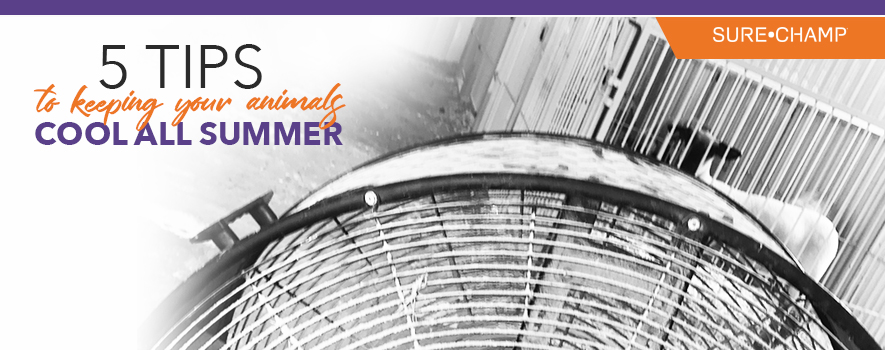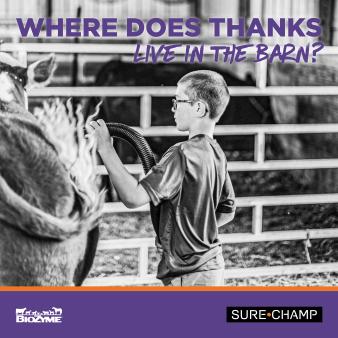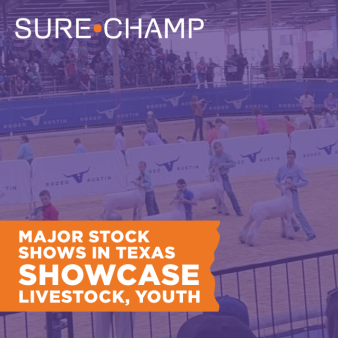
Summer temperatures are heating up, and the stakes are higher than ever. As the sun stays out longer, your days and hours in the barn get longer, but your time to prepare for the next big show gets shorter. Yet, no matter how many hours you put in or how much effort you make to get your stock ready, the summer heat and humidity can create heat stress, which can wreak havoc on your summer dreams of success.
For many parts of the country, with the cool, wet winter and spring we have been having, you may think that it isn’t even hot enough yet to worry about heat stress. But the reality is, anytime the temperature exceeds 70 degrees on a consistent basis, livestock are adversely affected. Heat stress can cause increased respiration rate, dehydration, fatigue and suppressed appetite – all sure signs of a lowered immune response. When you consider how these traits impact performance, it becomes evident that the strenuous expectations we put on our show livestock to perform at the highest level and look exceptional while doing so, clearly becomes a challenge.
As managers, it is imperative that we do just that – MANAGE our livestock. We all know a good manager is proactive, plans and follows through with that plan. By following the best practices and implementing some simple, but important steps, you can ensure fewer setbacks due to heat stress and experience greater success with your show livestock projects.
1. BE PROACTIVE
When preparing for the summer ahead, take a proactive approach. It is not good enough to react to a sudden temperature change. Watch the weather forecast and figure out when temperatures will be consistently warm every day. This will help guide your decision of when to bring animals in the barn for the summer. Also, pay attention to weather patterns throughout the day, this will help you dictate when to bring animals inside in the morning and when to turn them out at night. Make wise decisions based off the temperature. You don’t want to react to a sudden increase in temperature. It is much easier to monitor body temperature ahead of time versus trying to cool an animal down once they are already hot.
2. MANAGE YOUR FACILITY
The place your animal calls home can play a larger role in your animals’ temperature and comfort than you may think. First, make sure your animal has a place where they can get out of direct sunlight and into some shade. Not only does the sun quickly heat up the body temperature, but all animals can sunburn, which can then lead to flaky, dry and irritated skin. Second, pay attention to the air flow and temperature of your barn. Whether your facility at home has fans, misters or even a cooler, controlling airflow is so crucial to making animals comfortable through the summer. A good airflow in your facilities helps reduce temperatures, it creates a cool, dry environment that is less likely to attract pests or grow fungus and it will also help reduce odors. You can create optimal airflow in your barn through either ventilation, circulation or insulation.
You don’t have to have a cooler room to drastically reduce and manage the temperature of your barn. As long as you have shaded areas out of the sun, and can keep cool air moving through your barn, you can cool it down to a comfortable atmosphere.
3. MODIFY YOUR FEEDING STRATEGY
Just like humans, the hotter it gets, the less animals want to eat. To keep your animals eating consistently and performing, you should consider modifying your feeding program to accommodate cooler periods. Try feeding earlier in the mornings so they have a chance to eat and be moved into the barn before it gets hot, and wait until it starts to get a little cooler and darker to feed in the evening. You can also modify your feeding program by the ingredients you mix each day. If you can do so, try to avoid “hot” feeds that have a lot of corn or heavy starches in them. These take longer and require more energy to digest, which can increase internal body temperatures. If you do have to feed these feeds to push animals and get them fat, you should consider feeding a digestive supplement such as Sure Champ® Extreme with Climate Control. Sure Champ Extreme with Climate Control is a daily top-dress supplement that is formulated for cattle, hogs, sheep and goats and designed to help combat heat stress in the animals due to increased temperatures, high humidity or extreme shifts in temperatures or climate. It contains the Amaferm® is a prebiotic designed to enhance digestibility by amplifying the nutrient supply for maximum performance. It is research-proven to increase intake, digestion and absorption. In addition to Amaferm, it contains plant extracts that support the animal’s ability to maintain normal body temperatures. Extreme also contains garlic, to deter insects.
In addition to feed, don’t forget that water intake is an important part of your feeding routine. Make sure that your water lines serving as water sources are not exposed to the sun where they can get extremely hot. Consider that small troughs can provide more water flow, resulting in cooler water. Or if you don’t have an automatic water, consider checking your water every couple of hours to refill with cooler water. If you are concerned your animal is not drinking enough and runs the risk of dehydration, consider adding Vita Charge® Liquid Boost® to your water source to increase intake.
4. MAXIMIZE YOUR DAILY CARE
The summer is no time to slack off and cut your time spent in the barn. As temperatures increase, you need to think of the needs of your animal and what you can do to keep them as comfortable as possible. Rinsing animals with cool water multiple times a day will help drop their core temperature better than anything else you do. When rinsing on extremely hot days, start the water slowly on their feet, legs and belly before spraying water anywhere else. This will help cool them faster and starting at their legs will be less shocking for their system as they try to cool down. Don’t be afraid to spend some time letting the cool water run on their legs, belly and head. The more time you spend spraying them down in a focused area, the more it allows for their internal body temperatures to drop and become more comfortable.
5. PLAN FOR HEAT BEFORE YOU LEAVE
It doesn’t take long for livestock to feel the impact of heat stress when they are removed from the comforts of a temperature-controlled environment. As you prepare to head to a show in summer, it’s imperative you take these drastic temperature changes into consideration. If you have cattle in a cooler, it is very important to raise the temperature of the cooler a week to 10 days ahead, every day slowly increasing the thermostat to help them acclimate. Taking them straight from a cooler to a hot show will cause extreme stress which will lessen your opportunity for success. If you just have fans and misters, perhaps consider raising the temperature by just running the fans with no misters. When you prepare to leave, pack your trailer to maximize your airflow and ventilation. Do not stack equipment to where it blocks the airflow and ventilation as you drive. Additionally, prior to leaving you should check on the weather to plan when to leave, and only travel in cooler periods of the day, such as early morning and later in the evening.
Of course, these preparation tactics aren’t always fool proof and animals may still have a hard time adapting and staying cool at summer shows. In this case, you should adopt many of the same tactics mentioned; rinsing a few times a day, feeding earlier and later in the evening, keeping plenty of fans on your animals and taking cattle to tie outs later in the evening. If you need to help reduce body temperatures quickly, you can administer Vita Charge Climate Control Gel. Climate Control was designed to help all show livestock species handle heat stress by lowering the animal’s body temperature in a safe, fast and natural way. We suggest starting the gel a week to 10 days before a show and keeping livestock on the gel through return home from the show to keep them more relaxed, cool and comfortable, resulting in better appetite and higher energy levels allowing them to look their best on show day.
Heat stress can be a challenge to combat both at home and on the show road. However, with preparation and the right tools, you can be equipped to beat the heat EVERY. DAY. And #preptowin BIG in the summer!

